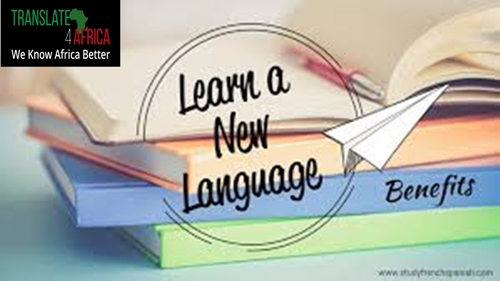Being able to communicate in a second language can be a privilege, especially when we are in this globalization era. How! Find-out here below in the article why and how learning a new language adds value to your life.
Benefits of learning a new language
It aids with brain growth
Studies have shown that people who are bilingual are better at multitasking and attention focusing. While speaking the second language, you require translating the words in your head. This requires a tremendous amount of focus. Brain scans have also shown that bilingual individuals have more gray matter in regions of the brain linked to executive functions.
It can improve your competitiveness in the job market
Knowing a second language makes your resume stand out and can boost you to the top of the interview list with potential employers. Companies today serve increasingly diverse, multilingual populations at home and abroad. Managers know that multilingual consumers are a huge commercial force and represent a significant opportunity for future business.
It can improve academics
Studies show that dual language students have somewhat higher test scores and also seem to be happier in school. Their attendance is better, behavioral problems fewer and parent involvement higher.
It strengthens native language abilities
People who diligently study a different language start to better understand their own native dialect. They begin to perform better in expressing thoughts in their own tongue.
Knowing a second language can open up new career opportunities
Foreign language skills can be particularly beneficial if you’re interested in changing careers to a new and growing field. Jobs as translators and interpreters are some of the fastest-growing occupations. There are a number of fields such as the military which actively recruits people within a variety of language skills. Other fast-growing fields like tourism and travel, healthcare and national security need employees with bilingual language skills and the ability to work across cultures. Fields such as journalism, education and international development are always in search of bilingual employees. And knowing a second language can give you an edge if you want to apply in those fields.
Increased communion
Truly learning a new language requires a person to dig deep into that particular culture. In your quest to understand their tongue you are grasping their ways. Learning a second language allows you to see things through the eyes of others. You begin to understand the way language shapes their way of thinking, which in turn allows you to feel more communions for them. And by having feeling for those faraway, you are also cultivating feeling for those closest to you.
It can slow the effects of old age
The benefits of learning a new language are life-long, but they seem especially important in old age. Cognitive flexibility which refers to the ability to adapt to unfamiliar or expected circumstances-tends to decline as we age; but speaking a second language can block that decline or at least significantly delay it. Research shows that bilingualism can improve cognition and delay dementia in older adults, particularly related to general intelligence and reading abilities.
And while bilingualism cannot prevent Alzheimer’s disease, but it can delay the onset of symptoms as much as five years. A recent study found that the brains of people who suffered from Alzheimer’s show the same physical deterioration whether they were monolingual or bilingual. But the people who speak two languages do not exhibit the typical symptoms of Alzheimer’s – such as memory loss, confusion, difficulties with problem-solving and planning until much later than those who only speak one language.
Increased quirky thinking
With automation becoming a usual part of society, creativity is a key component to better employment and opportunities. Computers and robots lack the necessary AI to think creatively, which is how you can set yourself apart. Imagination is the essential difference between the terminators and the human resistance. Learning a new language helps you experience the world through different lenses and approach problems in ways you may not normally consider.
So if you have the urge and are still struggling to learn a new language, here are some simple yet effective steps for you to master it faster.
Make full use of media
With the development of communication tools and the internet, you are able to approach the target language anytime anywhere. Even when you are driving, exercising, doing some gardening or cleaning, you can still learn by listening to the radio or music broadcast. The more you listen, the more you accustom yourself to the phonetics, intonation and accents of the native speakers.
You should pick up an online newspaper or magazine in the target language to start exploring the words and also the world. They are a rich source of new vocabulary and glossary for you. Reading is a natural and interesting way for you to run through the already-learnt words and structure, which effectively helps you get the feel of the target language.
Films, instructional videos and TV series are also the helpful sources for you to practice and experience the target language since they are clear, interactive and accessible. You will have a chance to learn how people make conversations in daily life and how they express their thoughts and feelings in the target language.
Interact with foreign/native friends
Hands down, the best way to learn a new language is to speak it. Too often, people spend all of their time studying grammar and memorizing lists of words instead of actually going out there and putting what they’ve learned into practice. Speaking with a real, live person will help you to feel much more motivated about learning the language than staring at a book, pamphlet or computer screen. Speaking to a foreigner helps you accustom your brain to think in the target language, which will sharpen your responsiveness and speaking skills. You should keep in mind that being fluent in a target language is the result of gradual interaction and consistent practice.
Do not worry about making mistakes
The fear of making mistakes can be the biggest obstacle on your way to master a language. Do not feel shy to speak out loud and to express your thoughts in the target language. The more mistakes you make, the more fluent you will be. Native speakers will not judge you by how accurately you pronounce or how well you make complex sentences. They will appreciate your efforts to communicate with them and even help you if you don’t mind.
Be patient and consistent by studying the language everyday
Learning a new language is not something that can be done overnight. It takes time before you are able to use a language like a native speaker. You have to let the language enter your mind and soul naturally, effortlessly. Knowledge about a language is endless; you cannot learn by heart all the vocabulary and phrasal verbs. Indeed, the learning process is like teaching your brain a new habit, which requires daily practice and repetition. Therefore, if you want quick results, you will only make the journey longer. Just take it step by step from basic to advanced level, do not rush to the finish line but try to enrich your language knowledge day by day.
All in all
Learning is a process, not a destination. And in the process, you have to complete yourself and sharpen your skills everyday. People often claim to have studied a language “for five years” and still not be fluent. But when they say five years, they probably mean that they studied the language for a couple of hours a week over that entire time period. Let’s get one thing clear; if your aiming at learning a new language quickly that is, in the space of a few weeks or months! You’re going to have to commit to studying the language for a couple of hours per day.
The journey to mastering/learning a new language would be easier if you have these secrets in hand. And remember that practice makes perfect. All the best!




